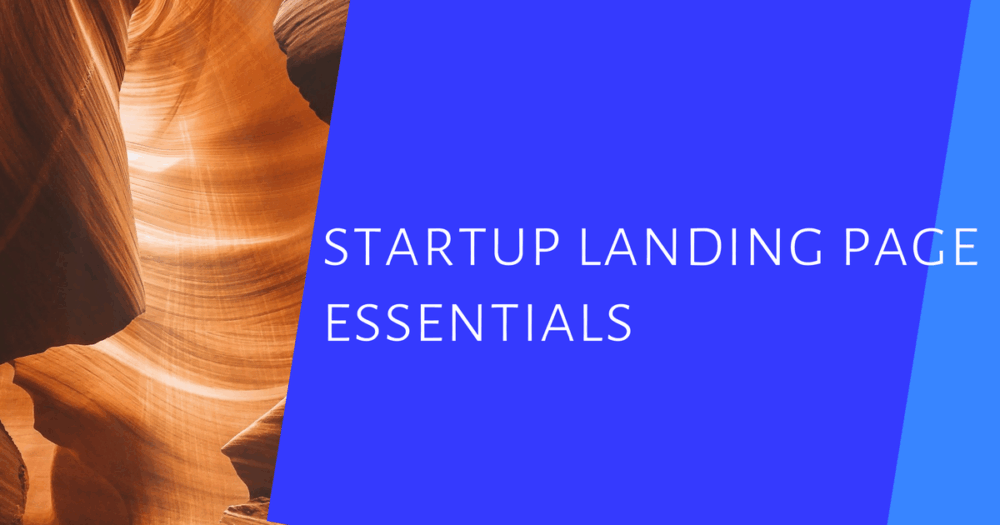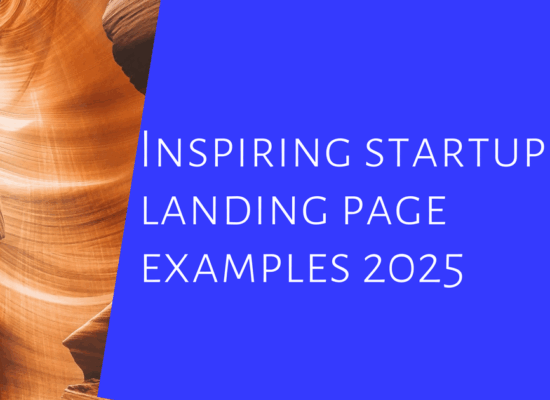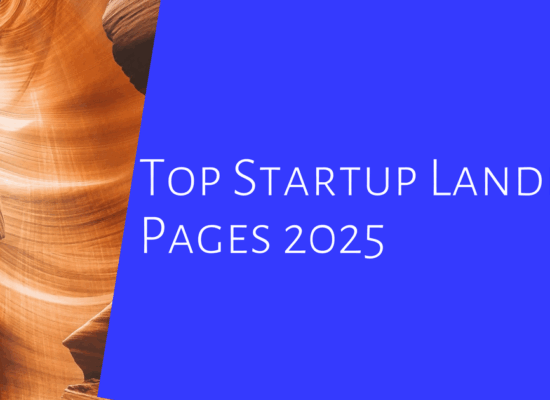Table of Contents
- Clear, Catchy, and Punchy Headline Above the Fold
- Strong Value Proposition with Supporting Subheaders
- Prominent Call to Action Positioned Above the Fold
- Focus on a Single Conversion Goal
- Benefit-Oriented Copy That Connects Emotionally
- Use Supporting Visuals and Multimedia
- Add Social Proof and Credibility Indicators
- Keep Lead Capture Forms Minimal and Logical
- Ensure Mobile-Responsive and Fast Loading Design
- Incorporate Interactive Elements Like Live Chat or Chatbots
- Provide Clear, Benefit-Focused Supporting Content
- Display Trust Signals and Guarantees
- Use Multiple CTAs for Longer Landing Pages
- Optimize SEO and Technical Elements
- Apply Continuous Testing and Analytics for Improvement
- Frequently Asked Questions
To make a startup landing page convert well in 2025, several key elements must be included. First, a clear and punchy headline above the fold grabs attention quickly, showing the core benefit. Supporting subheaders should explain what sets your product apart in simple terms that address customer needs. The call to action (CTA) must be prominent and visible without scrolling, encouraging immediate action with concise wording. Focus on a single conversion goal to reduce confusion and use benefit-driven copy instead of just features. Add social proof like testimonials for trust, keep forms minimal, ensure fast mobile-friendly design, and provide interactive support options like live chat to answer questions swiftly. Lastly, continuously test different versions of your page using analytics so you can improve conversions over time naturally and effectively.
Clear, Catchy, and Punchy Headline Above the Fold
The headline on your startup landing page is the first thing visitors see, so it must be clear, catchy, and punchy to grab attention within seconds. Keep it under 10 words to ensure it’s quick to read and easy to understand. Focus on your core value or unique selling proposition (USP), using simple language that avoids jargon. Incorporate emotional triggers that tap directly into your visitor’s needs or desires, making them feel understood and interested right away. Position the headline at the top center or top left of the page, aligning with natural eye flow for maximum visibility. Using action verbs can add energy and a sense of urgency, encouraging visitors to keep exploring. It’s important to test different headline variations to see which resonates best with your audience and matches their intent based on how they arrived at your page. Writing in an active voice helps create movement and relevance, making your message feel immediate and compelling. When needed, support the headline with a brief, impactful subheadline to clarify your offer and reinforce why visitors should stay engaged. For example, a headline like “Save Time with Smart Automation” paired with a subheadline explaining how your tool cuts daily tasks in half can quickly connect with busy professionals seeking efficiency.
| Tip | Description |
|---|---|
| Keep headline under 10 words | Ensures quick reading and immediate understanding by visitors |
| Focus on core value or USP | Highlights what makes your startup unique and valuable |
| Use emotional triggers | Connects directly to visitor needs or desires |
| Avoid jargon | Keeps message simple and easy to grasp |
| Position headline top center or left | Follows natural eye flow for maximum attention |
| Use action verbs | Adds energy and urgency to the headline |
| Test different headlines | Finds which variation grabs attention best |
| Align with visitor’s intent | Matches headline to traffic source for relevance |
| Use active voice | Creates a sense of movement and engagement |
| Support with subheadline | Adds clarity if needed with a short impactful line |
Strong Value Proposition with Supporting Subheaders
A strong value proposition clearly tells visitors how your startup solves their problems better than anyone else. Supporting subheaders break down this promise into specific benefits or solutions, making it easier for visitors to quickly grasp your unique edge. Use simple, direct language focused on customer pain points rather than technical jargon. For example, if your product saves time, a subheader might say “Cut Your Task Time in Half,” followed by bullet points that highlight key features enabling this. Placing these subheaders near relevant visuals or content helps visitors connect the dots faster. Bullet points work well to make benefits scannable, such as:
- Saves you hours every week
- Easy setup with no coding
- 24/7 customer support included
This format reinforces the main headline by providing concrete outcomes visitors can expect. Avoid overloading with product details; instead, keep the focus on what really matters to the customer. Testing different versions of these subheaders can reveal which phrasing resonates best and drives conversions. Consistency with your brand voice ensures the message feels authentic and trustworthy throughout the page.
- Use subheaders to explain how your product or service solves specific customer problems.
- Keep language clear and straightforward to avoid confusion.
- Highlight benefits that differentiate your startup from competitors.
- Address pain points directly to connect with visitor frustrations.
- Use bullet points for easy scanning of key features or advantages.
- Reinforce the headline’s promise with concrete details or outcomes.
- Avoid technical or product-heavy language in favor of customer-centric messaging.
- Position subheaders near related content or visuals for context.
- Test multiple versions to find the most convincing value propositions.
- Make the value proposition consistent with overall brand messaging and tone.
Prominent Call to Action Positioned Above the Fold
The primary call to action (CTA) should be placed where visitors see it immediately, usually just below or next to the headline, without any need to scroll. This spot above the fold is prime real estate because it captures attention right away. Use colors for your CTA button that sharply contrast with the rest of the page to make it pop visually. For example, a bright orange button on a mostly white or blue background draws the eye instantly. The text on the CTA must be clear and action-driven, stating exactly what the visitor will get, such as “Start Free Trial” or “Get My Demo.” Keeping the button size balanced is key: large enough to stand out but not so big it overwhelms other elements. Subtle design cues like arrows or small icons can guide the user’s gaze toward the button, increasing the chance of a click. Wording that creates a sense of ease or urgency, like “Try Now, Risk-Free,” encourages quick action without pressure. The button should look interactive, with hover effects or shadows that signal it’s clickable. Avoid cluttering this area with multiple CTAs to reduce confusion and decision fatigue. The CTA must align closely with the landing page’s single goal for conversion, making the next step obvious. Since many visitors come via mobile devices, ensure the CTA is easy to tap and responsive, keeping it accessible across all screen sizes. A well-designed, prominent CTA above the fold sets the tone for the entire user experience and significantly boosts conversion chances.
Focus on a Single Conversion Goal
Choosing one clear action for your landing page is key to boosting conversions. Whether it’s signing up, downloading, or making a purchase, this single conversion goal should guide every element on the page. Avoid cluttering the page with competing calls to action, as too many options can confuse visitors and reduce the chances they’ll complete the desired step. For longer pages, repeat the primary CTA in a consistent style at logical points to keep the goal front and center without overwhelming the user. Make sure navigation is simple and doesn’t lead visitors away from the page, which can distract from the main objective. Every piece of copy, image, and design should support this one goal, funneling visitors smoothly toward taking action. Keep forms straightforward with minimal fields to lower abandonment rates. Use analytics to track if narrowing the focus improves completion rates, and test different approaches to find the best fit. In practice, startups that simplify their landing pages around a single, strong conversion goal often see clearer user journeys and higher success in turning visitors into customers or leads.
Benefit-Oriented Copy That Connects Emotionally
Your landing page copy should answer the key visitor question: What’s in it for me? Focus on how your product or service makes life easier, better, or more fulfilling. Instead of just listing features, highlight the real outcomes users can expect. Use language that taps into hopes, fears, or desires, this emotional connection helps visitors see themselves benefiting from your solution. Address specific pain points clearly and show how your offering removes those obstacles. Keep paragraphs short and use bullet points for easy scanning. For example, instead of saying “Our app has advanced analytics,” say “You’ll gain clear insights to grow your business faster.” Speak directly to the visitor using “you” and “your” to create a personal tone. Balance this emotional appeal with practical details that build trust, avoiding overly technical jargon or vague promises. Real-life scenarios or customer stories make benefits tangible, like how a freelancer saved hours each week using your tool. Keep the tone conversational and approachable to keep readers engaged and eager to take the next step.
Use Supporting Visuals and Multimedia
High-quality visuals play a crucial role in making your startup landing page more engaging and trustworthy. Choose images that clearly relate to your product or service instead of generic stock photos, which often fail to connect or build trust with visitors. Videos or animations can be especially effective to quickly demonstrate how your solution works or what users can expect, giving a more tangible experience. Place these visuals strategically near relevant copy to reinforce your message and improve comprehension. A strong hero image or video above the fold grabs attention right away and sets the tone for the page. Including screenshots or product demos can clarify complex features and reduce visitor hesitation. However, avoid clutter by limiting the number of visuals; too many images or animations can distract or slow down the page. Speaking of speed, always optimize media files for fast loading without sacrificing quality, ensuring a smooth experience across all devices. Make sure all visuals are responsive so they display well on smartphones, tablets, and desktops alike. Finally, test different types of media to see which formats boost engagement and conversions, since what works best can vary depending on your audience and offering.
Add Social Proof and Credibility Indicators
Including social proof on your startup landing page is essential to build trust and convince visitors that your product or service delivers real value. Start with authentic testimonials from real customers, ideally with names and photos, which add a personal touch and credibility. Displaying logos of well-known clients or partners can quickly boost trust by association. Star ratings and reviews should be prominently placed, as they provide quick visual cues of satisfaction. Case studies or success stories with clear, measurable results show the impact your offering has made, helping prospects see the potential benefits for themselves. Real-time activity notifications, like recent purchases or sign-ups, create a sense of urgency and social activity, encouraging visitors to join in. Adding trust badges such as security seals, certifications, or awards further reduces hesitation by signaling reliability and professionalism. To maintain authenticity, keep all social proof updated and avoid overloading the page, which can feel overwhelming or spammy. Embedding social media mentions or influencer endorsements can add another layer of credibility if relevant to your audience. Combining different types of social proof strategically strengthens your page’s trustworthiness and helps visitors move confidently toward conversion.
Keep Lead Capture Forms Minimal and Logical
To maximize conversions, your lead capture forms should be as simple and logical as possible. Start by asking only for essential information like name and email to reduce friction and encourage more sign-ups. If you need more details, break the form into multiple smaller steps rather than overwhelming users with a long single form. This multi-step approach helps keep users engaged and lowers abandonment rates.
Place forms in obvious locations on the page, ideally above the fold or right after you list key benefits. Clear, descriptive labels on each field and inline validation help prevent errors and confusion, making the process smooth. Since mobile users make up a large part of traffic, ensure forms are mobile-friendly with large tap targets and straightforward input methods.
Use submit buttons with clear, benefit-focused text like “Get Started” or “Claim Offer” instead of generic phrases to reinforce what the user gains by converting. Avoid optional fields that aren’t necessary, as these can discourage completion. Always provide privacy assurances explaining how the data will be used to build trust.
Finally, continuously test form length and complexity while monitoring analytics for abandonment rates. This data-driven approach allows you to find the right balance between collecting quality information and maintaining high conversion rates.
Ensure Mobile-Responsive and Fast Loading Design
In 2025, most visitors will access your startup landing page on mobile devices, making a mobile-responsive design non-negotiable. Your page should adapt smoothly to different screen sizes and orientations, using responsive images and scalable vector graphics to keep visuals sharp without slowing down the load time. Heavy scripts and large media files can drag down performance, so keep them minimal and optimized. Regularly test your page speed with tools like Google PageSpeed Insights or GTmetrix to catch issues early. Navigation must be simple and intuitive on small screens, avoiding pop-ups that block content or frustrate users. Fast hosting combined with Content Delivery Networks (CDNs) ensures your page loads quickly no matter where visitors are located. Fonts and buttons should be easy to read and tap, improving usability and reducing mistakes. A clean, uncluttered layout not only looks professional but also helps prevent slowdowns. Finally, make sure your forms and calls to action work seamlessly on touchscreens to avoid losing potential conversions due to poor mobile experience.
Incorporate Interactive Elements Like Live Chat or Chatbots
Adding live chat options to your landing page offers real-time support that helps visitors get quick answers to their questions, reducing hesitation and boosting conversions. AI-powered chatbots take this a step further by handling common queries 24/7, qualifying leads automatically, and freeing up your team for more complex tasks. Position chat widgets in a way that’s easy to find but doesn’t distract, usually the lower right corner works best. Personalizing chat greetings based on where visitors came from or what they’ve done on your site helps create a more engaging experience. Integrating chat tools with your CRM ensures that leads are tracked and managed efficiently, improving follow-up and nurturing. You can also use chat to address objections or concerns immediately, smoothing the path to conversion. Monitoring chat transcripts is valuable for spotting recurring questions or pain points, which you can then use to improve your page content. It’s important to keep chat features lightweight to avoid slowing down your page load speed. Offering proactive chat invitations based on visitor behavior, like time spent or specific actions, can increase engagement without feeling pushy. Finally, make sure human support is available when questions go beyond what a chatbot can handle, maintaining trust and a personal touch.
Provide Clear, Benefit-Focused Supporting Content
Use short paragraphs and bullet points to make benefits easy to scan. Explain clearly how your product solves specific problems or improves daily life, focusing on what visitors truly gain rather than just listing features. Briefly compare your solution with common alternatives to highlight advantages, helping visitors understand why your startup stands out. Address doubts or objections they might have upfront, such as pricing concerns or ease of use, to build trust. Use simple, relatable language that speaks directly to your target audience’s needs and emotions. Include real-life examples or user scenarios to show how your product fits into everyday situations, making the value tangible. Keep content concise and scannable, avoiding overwhelming details, and use headings or subheaders that reinforce the key benefits clearly. Finally, link this supporting content back to your main value proposition and call to action, ensuring visitors see a clear path from understanding benefits to taking the next step.
Display Trust Signals and Guarantees
Trust signals and guarantees are critical to easing visitor hesitation and boosting conversions on your startup landing page. Start by showcasing genuine customer testimonials complete with real names and photos when possible, as this personal touch makes feedback more believable. Adding recognizable client logos or partner brands further enhances credibility by association, while star ratings or reviews from trusted third-party platforms provide social proof that your product delivers. Security badges like SSL certificates reassure visitors their data and payments are safe, which is particularly important for e-commerce or SaaS startups. Offering guarantees such as money-back promises or free trials reduces perceived risk, encouraging prospects to take action without fear of loss. Make sure to mention compliance with privacy regulations like GDPR to demonstrate your commitment to user data protection. Highlighting any relevant awards, certifications, or endorsements can also set your startup apart as trustworthy and validated by experts. Real-time activity notifications, such as live purchase alerts, create a sense of urgency and prove that others are buying, adding another layer of social proof. If your startup has been featured in the press, displaying media logos or quotes can strengthen your reputation. Lastly, place these trust signals near your call-to-action buttons and lead forms so visitors see them right before converting, reinforcing confidence and lowering barriers to commitment.
Use Multiple CTAs for Longer Landing Pages
For longer landing pages, using multiple CTAs strategically placed throughout the page boosts conversion chances. Start with a primary CTA above the fold that’s clear, benefit-driven, and visually distinct so visitors can act immediately. As users scroll, repeat this CTA at logical points, maintaining consistent style, color, and wording to avoid confusion. Each button should clearly communicate the value and action, like “Start Free Trial Now” or “Get My Demo,” incorporating subtle urgency or zero-risk language. Avoid overwhelming visitors with conflicting CTAs; instead, include secondary CTAs such as “Learn More” or “Watch Demo” for those not ready to commit yet. Make sure all CTAs are easy to find on both desktop and mobile devices. Testing different placements and copy helps identify what resonates best with your audience. This consistent, user-friendly approach keeps the conversion path clear and accessible regardless of how far visitors scroll.
Optimize SEO and Technical Elements
To ensure your startup landing page converts well in 2025, optimizing SEO and technical elements is essential. Start by crafting a clear, keyword-rich page title that aligns with what your audience is searching for, helping your page appear in relevant search results. Complement this with a compelling meta description that encourages clicks by summarizing the page’s value in a few engaging sentences. Use header tags (H1, H2, H3) to organize your content logically and include relevant keywords, making it easier for both users and search engines to understand your message. Fast page load times are crucial; optimize images by compressing them without losing quality and reduce unnecessary scripts that slow down the site. Clean, semantic HTML code improves crawlability, allowing search engines to index your page accurately. Implement schema markup to enhance search results with rich snippets, which can increase visibility and click-through rates. If your landing page is part of a larger website, build a logical internal linking structure to guide visitors and distribute SEO value effectively. Keep URLs short, descriptive, and SEO-friendly to improve readability and ranking. Mobile optimization is non-negotiable since Google prioritizes mobile-first indexing; ensure your page looks and works perfectly across all devices. Finally, regularly audit your technical SEO to fix broken links, redirects, or any errors that could harm user experience or search rankings. These technical details may seem minor, but they build a solid foundation that supports your landing page’s conversion goals.
Apply Continuous Testing and Analytics for Improvement
Continuous testing and analytics are crucial for turning your landing page into a high-converting asset. Start by setting up A/B tests to compare different headlines, CTA text, colors, and layouts. This systematic approach helps you identify which elements resonate best with your audience. Track key metrics like conversion rate, bounce rate, and average session duration to understand visitor behavior and spot areas for improvement. Heatmaps reveal where users click, scroll, or drop off, while session recordings provide deeper insights into navigation patterns and pain points. To gather direct feedback, use brief surveys or polls on your landing page, which can highlight issues that numbers alone might miss. Analyze form abandonment rates to fine-tune your lead capture fields, reducing friction and boosting sign-ups. Testing various value propositions and messaging ensures your startup’s core benefits come through clearly. Additionally, monitor traffic sources closely to tailor content for different visitor segments, improving relevance and engagement. Regularly review all analytics and plan iterative improvements based on data, documenting test results and changes as you go. This ongoing process builds a knowledge base about what works for your audience, enabling smarter decisions and steady conversion growth over time.
Frequently Asked Questions
1. How can a clear headline improve my startup landing page’s conversion rate?
A clear headline quickly tells visitors what your startup offers and why it matters. It sets expectations and grabs attention, making it easier for visitors to decide whether to stay and learn more, which helps increase conversions.
2. Why is it important to include social proof like testimonials or reviews on a startup landing page?
Social proof builds trust by showing real experiences from customers or users. It reassures visitors that your startup is reliable and that others found value in your product or service, which makes them more likely to convert.
3. What role do call-to-action buttons play in guiding visitors on a startup landing page?
Call-to-action (CTA) buttons direct visitors toward the next step, like signing up or buying. Well-placed, clear CTAs reduce confusion and encourage action, which is crucial for turning visitors into customers or leads.
4. How does page loading speed affect the effectiveness of a startup landing page?
If your landing page loads slowly, visitors may get frustrated and leave before seeing your message. Fast loading keeps visitors engaged and reduces bounce rates, making it more likely that they complete the desired action.
5. Why should a startup landing page include mobile-friendly design elements?
More people browse on mobile devices, so a landing page that works well on phones and tablets ensures a good user experience for everyone. Mobile-friendly design means visitors can easily navigate and convert, regardless of device.
TL;DR A startup landing page that converts well in 2025 needs a clear, engaging headline and a strong value proposition right above the fold, plus a prominent, benefit-focused call to action. Focus on a single conversion goal, use emotional benefit-driven copy, and support it with high-quality visuals and social proof. Keep lead capture forms simple and make sure the design is fast and mobile-friendly. Adding interactive elements like live chat can help, as can trust signals, multiple CTAs for longer pages, and SEO optimization. Finally, constantly test and analyze your page to improve performance based on real data.




